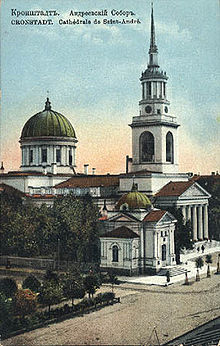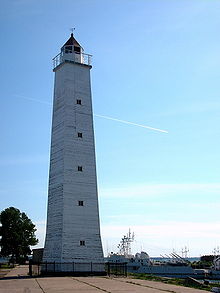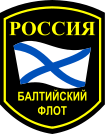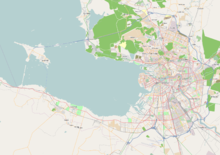- Kronstadt
-
For other uses, see Kronstadt (disambiguation).
Kronstadt (English)
Кронштадт (Russian)- Municipal town[citation needed] - Coordinates: 60°00′N 29°46′E / 60°N 29.767°ECoordinates: 60°00′N 29°46′E / 60°N 29.767°E Coat of arms Flag Administrative status Country Russia Federal subject Saint Petersburg Administrative center of Kronshtadtsky District[citation needed] Statistics Area 19.35 km2 (7.47 sq mi)[citation needed] Population (2010 Census,
preliminary)42,999 inhabitants[1] Population (2002 Census) 43,385 inhabitants[2] Density 2,222 /km2 (5,750 /sq mi)[3] Time zone MSD (UTC+04:00)[4] Founded 1704[citation needed] Dialing code(s) +7 812[citation needed] , http://www.kotlin.ru/ Official website Kronstadt (Russian: Кроншта́дт), also spelled Kronshtadt, Cronstadt (German: Krone for "crown" and Stadt for "city"); (Finnish: Retusaari) is a municipal town in Kronshtadtsky District of the federal city of St. Petersburg, Russia, located on Kotlin Island, 30 kilometers (19 mi) west of Saint Petersburg proper near the head of the Gulf of Finland. Population: 42,999 (2010 Census preliminary results);[1] 43,385 (2002 Census).[2]
It is also St. Petersburg's main seaport. In March 1921 it was the site of the Kronstadt rebellion.
Traditionally, the seat of the Russian admiralty and the base of the Russian Baltic Fleet were located in Kronstadt guarding the approaches to Saint Petersburg. The historic centre of the city and its fortifications are part of the World Heritage Site Saint Petersburg and Related Groups of Monuments.
Kronstadt has been a place of pilgrimage for Orthodox Christians for many years due to the holy memory of Saint John of Kronstadt. Bus and water tours to Kronstadt are taken daily from Saint Petersburg[5]
Contents
History
 The Cathedral of St. Andrew (1817-1932), dedicated to the patron saint of the Russian Navy. It was destroyed under the Soviet regime in 1932.
The Cathedral of St. Andrew (1817-1932), dedicated to the patron saint of the Russian Navy. It was destroyed under the Soviet regime in 1932.
 Monument to Peter the Great, the founder of Kronstadt.
Monument to Peter the Great, the founder of Kronstadt.
Kronstadt was founded by Peter the Great, who took the island of Kotlin from the Swedes in 1703. Pushkin's great-grandfather, Abram Petrovich Gannibal, oversaw its construction.[6][dubious ] The first fortifications were inaugurated on 18 May 1704.
These fortifications, known as Kronstadt's Forts, were constructed very quickly. During the winter the Gulf of Finland freezes completely. Workers used thousands of frames made of oak logs filled with stones. These were carried by horses across the frozen sea, and placed in cuttings made in the ice. Thus, several new small islands were created, and forts were erected on them, closing all access to Saint-Petersburg by the sea. Only two narrow navigable channels remained, and the strongest forts guarded them.
Kronstadt was thoroughly refortified in the 19th century. The old three-decker forts, five in number, which formerly constituted the principal defences of the place, and defied the Anglo-French fleets during the Crimean War, became of secondary importance. From the plans of Eduard Totleben a new fort, Constantine, and four batteries were constructed (1856–1871) to defend the principal approach, and seven batteries to cover the shallower northern channel. All these fortifications were low and thickly-armored earthworks, powerfully armed with heavy Krupp guns in turrets. The town itself is surrounded with an enceinte.
In summer 1891, the French fleet was officially — and triumphally — received in Kronstadt. It was a first step towards the coming Franco-Russian Alliance.
Civil War
During the Petrograd riots of the February revolution, the sailors of Petrograd joined the revolution and executed their officers, and received a reputation as dedicated revolutionaries. During the civil war, the sailors participated on the red side, until 1921, when they rebelled against the Bolshevik rule.
Kronstadt and the supporting forts and minefields were the key to the protection of Petrograd from foreign forces. Despite this, the cruiser Oleg was torpedoed and sunk by a small motor boat after participating in a bombardment of Krasnaya Gorka fort that had revolted against the Bolsheviks.[7] this was followed on 18 August 1919 by a raid of seven Royal Navy Coastal Motor Boats into the harbor of Kronstadt itself damaging the Soviet battleships Petropavlovsk and Andrei Pervozvanny sinking a submarine supply ship, the Pamiat Azova.
Kronstadt Rebellion
Main article: Kronstadt rebellionIn 1921, a group of sailors and soldiers and their civilian supporters rebelled against the Bolshevik government in Soviet Kronstadt. The garrison had previously been a centre of major support for the Bolsheviks, and throughout the Civil War of 1917–1921, the sailors of Kronstadt had been at the vanguard of the main Bolshevik attacks. Their demands included "freedom of speech", a stop to the deportation to work camps, a change of Soviet war politics, and the removal of the soviets (workers' councils) from "party control" [1]. After brief negotiations, Leon Trotsky (then the Minister of War in the Soviet Government, and the leader of the Red Army) answered by sending the army to Kronstadt, along with the Cheka, and the uprising was suppressed.
World War II
During World War II, Kronstadt was bombed several times by Nazi Germany's air force, the Luftwaffe. The most notable bombing was Stuka ace Hans-Ulrich Rudel's sinking of the Soviet battleship Marat.
Main sights
The town of Kronstadt is built on level ground and is thus exposed to inundations, the most famous being in 1824. On the south side of the town there are three harbors: the large western or merchant harbor, the western flank of which is formed by a great mole joining the fortifications which traverse the breadth of the island on this side; the middle harbor, used chiefly for fitting out and repairing vessels; and the eastern or war harbor for vessels of the Russian navy. The Peter and Catherine canals, communicating with the merchant and middle harbours, traverse the town. Between them stood the old Italian palace of Prince Menshikov, the site of which was later occupied by a pilot school.
The modern town's most striking landmark is the enormous Naval Cathedral, built from 1908 to 1913 and considered to represent a culmination of the Russian Neo-Byzantism. The older St Andrew Cathedral (1817), formerly Kronstadt's pride and beauty, was destroyed on communist orders in 1932. St John of Kronstadt, one of the most venerated Russian saints, served there as a priest from 1855-1908.
 Kronstadt lighthouse.
Kronstadt lighthouse.
Among other public buildings are the naval hospital, the British seamen's hospital (established in 1867), the civic hospital, admiralty (founded 1785), arsenal, dockyards and foundries, school of marine engineering, and the English church. The port is ice-bound for 140–160 days in the year, from the beginning of December to April. A very large proportion of the inhabitants are sailors.
The Kronstadt Sea Fortress used to be considered the most fortified port in the world. Kronstadt still retains some of the "forts", small fortified artificial islands. Formerly, there were 42 such forts, situated in line between the southern and northern shores of the Gulf of Finland. Some fortifications were located inside the city itself and one was on the western shore of the Kronslot Island (on the other side of the main navigational channel).
Nowadays, the construction of the Saint Petersburg Dam has led to some of the forts being demolished. The dam also permitted Kronstadt and some of the forts to be reached without using a boat. Among the most important surviving forts are the Fort Konstantin, the biggest in the Gulf of Finland; the Fort Rif on the western shore of the island; and the particularly well-preserved Chumnoy Fort (Plague Fort). The largest and the newest of the forts, constructed at the beginning of the 20th century, is Fort Totleben, named after Eduard Totleben.
International relations
Twin towns/sister cities
Kronstadt is twinned with:
References
- ^ a b Федеральная служба государственной статистики (Federal State Statistics Service) (2011). "Предварительные итоги Всероссийской переписи населения 2010 года (Preliminary results of the 2010 All-Russian Population Census)" (in Russian). Всероссийская перепись населения 2010 года (All-Russia Population Census of 2010). Federal State Statistics Service. http://www.perepis-2010.ru/results_of_the_census/results-inform.php. Retrieved 2011-04-25.
- ^ a b Федеральная служба государственной статистики (Federal State Statistics Service) (2004-05-21). "Численность населения России, субъектов Российской Федерации в составе федеральных округов, районов, городских поселений, сельских населённых пунктов – районных центров и сельских населённых пунктов с населением 3 тысячи и более человек (Population of Russia, its federal districts, federal subjects, districts, urban localities, rural localities—administrative centers, and rural localities with population of over 3,000)" (in Russian). Всероссийская перепись населения 2002 года (All-Russia Population Census of 2002). Federal State Statistics Service. http://www.perepis2002.ru/ct/doc/1_TOM_01_04.xls. Retrieved 2010-03-23.
- ^ The value of density was calculated automatically by dividing the 2010 Census population by the area specified in the infobox. Please note that this value may not be accurate as the area specified in the infobox does not necessarily correspond to the area of the entity proper or is reported for the same year as the population.
- ^ Правительство Российской Федерации. Постановление №725 от 31 августа 2011 г. «О составе территорий, образующих каждую часовую зону, и порядке исчисления времени в часовых зонах, а также о признании утратившими силу отдельных Постановлений Правительства Российской Федерации». Вступил в силу по истечении 7 дней после дня официального опубликования. Опубликован: "Российская Газета", №197, 6 сентября 2011 г. (Government of the Russian Federation. Resolution #725 of August 31, 2011 On the Composition of the Territories Included into Each Time Zone and on the Procedures of Timekeeping in the Time Zones, as Well as on Abrogation of Several Resolutions of the Government of the Russian Federation. Effective as of after 7 days following the day of the official publication).
- ^ "Boat tour to Kronstadt". http://www.tourmandu.com/local-tours/St-Petersburg-Russian-Federation/5866/Tour-of-season-Boat-tour-to-Kronstadt/812/.
- ^ Barnes, Hugh (2005). The Stolen Prince: Gannibal, Adopted Son of Peter the Great, Great-Grandfather of Alexander Pushkin, and Europe's First Black Intellectual. HarperCollins. ISBN 0066212650.
- ^ Ingrian nationalists, according to Operation Kornstadt
 This article incorporates text from a publication now in the public domain: Chisholm, Hugh, ed (1911). Encyclopædia Britannica (11th ed.). Cambridge University Press.
This article incorporates text from a publication now in the public domain: Chisholm, Hugh, ed (1911). Encyclopædia Britannica (11th ed.). Cambridge University Press.
External links
- Kronstadt history
- Kronstadt web site
- Map of Kronstadt
- Kronstadt: Virtual Excursion
- International Kronstadt Development Fund
Cities and towns under the jurisdiction of Saint Petersburg  Kolpino · Krasnoye Selo · Kronstadt · Lomonosov · Pavlovsk · Petergof · Pushkin · Sestroretsk · Zelenogorsk
Kolpino · Krasnoye Selo · Kronstadt · Lomonosov · Pavlovsk · Petergof · Pushkin · Sestroretsk · Zelenogorsk
Major fortresses of Western Russia 
Baltic Fleet of Russian navy Commander of fleet Vice Admiral V. V. Chirkov
Divisions Leningrad Naval Base · Baltiysk Naval base · Separate Guards brigade of marines of the Baltic fleet · 127 separate sea engineering battalion · Strazh Balticy (newspaper)Navy bases in Kaliningrad Oblast Fleet command: Kaliningrad • Marine base: Baltiysk • Air bases: Chernyakhovsk · Kaliningrad Chkalovsk · Donskoye · KhrabrovoNavy base in Saint Petersburg and Oblast Former Naval Bases Page of Baltic fleet in Official site of Ministry of Defence Military educational institutions Naval academy of a name of N. G. Kuznetsov …
Military research institutes and design offices Malachite design office …The military ship-building and ship-repair enterprises Admiralty Shipyard · Almaz Shipbuilding Company · Baltic Shipyard · Rubin Design Bureau · Severnaya Verf · Severnoye Design BureauPart of Leningrad Naval base Cities of Military Glory of Russia Arkhangelsk · Belgorod · Bryansk · Dmitrov · Kalach-na-Donu · Kozelsk · Kronstadt · Kursk · Luga · Malgobek · Nalchik · Naro-Fominsk · Oryol · Polyarny · Pskov · Rostov-on-Don · Rzhev · Tikhvin · Tuapse · Tver · Velikiye Luki · Veliky Novgorod · Vladikavkaz · Vladivostok · Volokolamsk · Voronezh · Vyazma · Vyborg · Yelets · Yelnya
Categories:- Cities and towns under jurisdiction of Saint Petersburg
- Baltic fleet
- Russian and Soviet Navy bases
- Populated coastal places in Russia
- History of Saint Petersburg
- Cities of Military Glory
- World Heritage Sites in Russia
Wikimedia Foundation. 2010.





